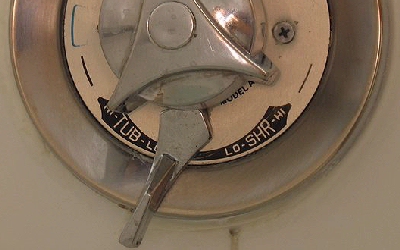Bathtub/shower faucets.
Shower pressure balancing taps |
|
Three handle tap system.
Left and right handles: Hot and cold.
Centre handle: Diverter valve.
Directs water to tub or showerhead |
|
Single lever pressure balancing
system with diverter valve (arrow) on tub spout..
Pull or press knob to direct water to tub
or showerhead. |
|
Single lever pressure
balancing
system for showers |
|
| Bathtub/Shower Diverter Systems and Shower Taps |
|
|
Bathtub/shower faucets. Shower pressure balancing taps
WARNING about lead content.
Most faucets purchased prior to late 1990s were constructed of brass or chrome-plated brass, which contain up to 8 percent lead. Look for faucets that are labeled "Low Lead Compliant".
For more information go to "Lead in Drinking Water" |
There are many different type of taps. The more common ones used for showers and bathtub/shower combo installations are described below.
- Three handle taps
- Two handle taps
- Single handle mixer taps
- Pressure balancing taps
- Finishes
- More helpful links
THREE HANDLE TAP SYSTEMS (for bathtub/shower installations)
The three handle tap system was mainly used for bathtub/shower combo installations. Over time, many of the older three handle systems have been replaced by mixer taps and/or pressure balancing taps.
A three-handle shower and tub system has two handles that control hot and cold water flow and a center handle that controls the shower diverter valve which directs water through either the tub spout or the shower head.
Pressure balance valves, see below, for showers are now required by building codes in many municipalities for all new or retrofit installations.
 Single lever tap mixer system for tub/shower use
Single lever tap mixer system for tub/shower use |
|
|
|
TWO HANDLE TAP SYSTEMS (for bathtub/shower installations)
A two-handle system has a lever on the tub spout that engages the shower diverter valve. The tube-shaped shower diverter valve sits behind the diverter knob or lever in a combination shower and bathtub setup.
A shower diverter valve directs water through either the tub spout or the shower head.
With this type of tap system you should first divert the water to the tub spout and keep adjusting either tap till you have found the right temperature. After the water reaches the desired temperature, you turn or pull the diverter knob on the the tub spout and the water will be diverted to the showerhead.
Pressure balance valves, see below, for showers are now required by building codes in many municipalities for all new or retrofit installations.
SINGLE LEAVER TAP MIXER SYSTEMS (for bathtub/shower installations)
Single tap systems for bathtub/shower installations have a diverter valve which directs the water to either to the shower head or tub spout. Water flow direction can be controlled by a lever marked Tub or SHR (shower). There are also red and blue stripes or arrows to indicate which side will provide hot or cold water.
Older single bathtub/shower taps do not have a pressure balance valve and it may be a good idea to have the unit replaced by a pressure balance tap to prevent dramatic temperature changes by sensing pressure fluctuations in water pipes.
Pressure balance valves, see below, for showers are now required by building codes in many municipalities for all new or retrofit installations.
PRESSURE BALANCING TAPS
Just like the double handle taps, pressure balancing taps are colour coded and have a red-blue stripe or arrows indicating which side will give hot or cold water. This type of tap provides water at nearly constant temperatures to the shower by compensating for water pressure fluctuation. There is a good reason why we need a pressure balancing tap in the shower. If, for example, someone flushes a toilet or opens a cold water tap while the shower is in use, the fixture suddenly draws a significant amount of cold water from the common supply line, causing a pressure drop. As the water pressure drops on one supply line, the valve reduces the pressure in the other supply line to match. In the absence of a compensating mechanism, the relatively higher pressure in the hot water supply line will cause the shower temperature to rise just as suddenly, possibly reaching an uncomfortable or even dangerous level. Conversely, if someone opens a hot water faucet elsewhere, the relatively higher pressure in the cold water supply line will cause the shower temperature to drop suddenly. So, in short, the main purpose of the pressure balancing tap is to prevent scalding or chilling. The installation of pressure balancing taps for showers is now required by code in virtually all municipalities.
FAUCET FINISHES
Regardless of appearances, faucets are usually made of brass. So your 'brushed nickel' faucet is made of brass but has a nickel finish. Depending on brand and manufacturer other finishes are marketed as antique brass, gold, satin nickel, oil rubbed bronze, polished copper, stainless steel, chrome and porcelain. Victorian style fixtures are often made of chrome or polished brass and porcelain handles. These taps are ideal for retrofitting an old clawfoot tub.
Some kitchen taps are made of plastic. They are usually very stylish, less expensive than brass but not as long lasting.
FOR MORE INFORMATION SEE ALSO
Faucets - Kitchen, Bathroom
Faucets - Hose bibb, spigot, sill cock
Faucets - Warning about air gap and cross contamination
Laundry Tubs, Sinks and Taps
Lead in drinking water from faucets, solder and watermains |
|
|
|
|
Back to Top |
|